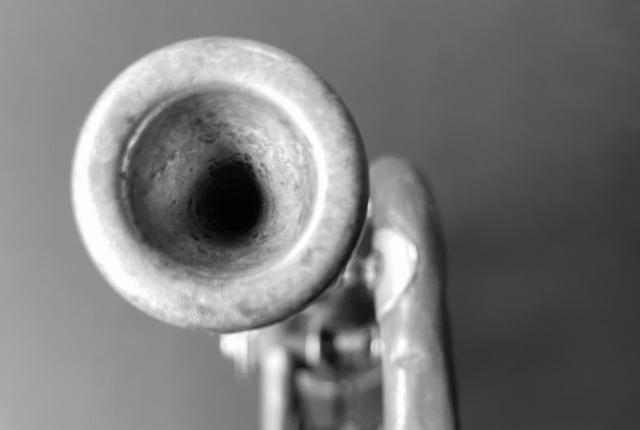Embouchure is a word most people outside music have never heard of, but if you’re learning how to play the trumpet, how to achieve a good trumpet embouchure will be an important topic for you for a long time. Let’s look what it is and how to make your embouchure good.
What is an embouchure in music?
The embouchure of a trumpeter (pronounced: ahm-boo-sure) is the use of mouth, lips, tongue and teeth when playing the instrument. The way the embouchure is formed on the mouthpiehas e an effect on the tone and quality of the sound produced.
Resources To Help Improve Embouchure
If you need more help with your embouchure, take a look at these resources:
The Embouchure Builder*
Warburton P.E.T.E. (Personal Embouchure Training Device)*
Superchops* (if you can find it)
Why is embouchure important?
For a trumpet player or learner, achieving a good embouchure means getting a proper link between the player and the trumpet and lets them efficiently transfer air to the mouthpiece. Good trumpet embouchure will ensure that you get better intonation, tone, and control of sound because the quality and effectiveness of all these things rely on the embouchure.
Additionally, good trumpet embouchure ensure that you get the correct balance between breath support and tension in the muscles. If you have a weak embouchure, it means that there is a problem hidden somewhere. Some of the possible problems could be the way you support your breath or the posture you have adopted while you play.
But in as much as good embouchure is necessary, it may be challenging to attain it especially if you are not adequately skilled and experienced. However, it is possible to achieve mastery as long as you do it with determination and constant practice.
Keep your lips firm and their placement consistent. You can attain better trumpet embouchure if you form your lips and maintain a consistent placement. Try to set your lips as if you were buzzing and then place the mouthpiece on the lips that way.
Additionally, you need to practice breathing through your mouth. This practice, though a bit challenging, will enable you to get enough deep breath to allow you to play your trumpet effectively.
What about buzzing?
Free buzzing is another ingredient that constitutes good embouchure. Buzzing at the lowest and highest pitches will enable you to know how to navigate and transition between two extreme tones without difficulty.
You can try rolling your lower lips over your lower teeth so that your mouth corners in the right position as you slowly and steadily develop the strength to control your lower lips and get them off your teeth. Even if this seems hard at first, it’s definitely possible to learn to buzz freely.
Should I attempt a ‘smile embouchure’?
As a beginner, you may be tempted to smile while trumpeting. However, this smile embouchure will reduce the degree of your playing effectiveness because the corners of your mouth are supposed to be locked into place while you play the trumpet. Smiling while playing the trumpet will limit your upper register and endurance, so it’s best not to get into the habit in the first place.
Looking for a teacher?
Want to get lessons at the comfort of your own home? Check out the course Learn to Play the Trumpet: Beginner to Pro Made the Easy Way* on Udemy! (See their full trumpet course line-up here*!)
What do I do with my chin?
For a veteran, bunching one’s lips may not be a big issue; but for a learner, the temptation to push up one’s lips as they ascend is real. On many occasions, inexperienced players tend to push their chins up towards their lips as they play ascending notes and end up disengaging their jaws from their chins. Make sure that you avoid this behavior as much as possible because it will limit your progression and precision.
Wet lips or dry lips?
In the pursuit of better embouchure, you need to pay attention to the wetness or dryness of your lips. You need to strike a good balance so that your lips are just dry enough to stick to the mouthpiece well. On the other hand, wet lips tend to slide under the mouthpiece, and they need to be adjusted to strike the perfect balance.
How best to breathe for better embouchure?
Another area you need to pay attention to is your breathing. You are supposed to take a full and deep breath and also ensure that you don’t lift shoulders when breathing in. You need to relax while taking in air and just inhale in tempo and blow instantly.
What posture to pick for better embouchure?
The last thing that will help you form better embouchure is your posture as you play. Don’t point the bell of your trumpet to the floor. Also, don’t try to lock your knees but on the contrary, remain in a relaxed position. Make sure that you place your hands away from your body.
Ensuring a good posture will make sure that you can breathe freely and this will already help you form better embouchure. Good posturing will ensure that you inhale easily, so it’s best to blow the trumpet while standing. If you must sit, make sure you sit in an upright position.
A Note on Valves
You also need to pay attention to how you press the valves. Try to push the valve straight down with the cushions of your fingers. While blowing, always ensure that your nails do not touch the finger button and joints.
Practice Makes Perfect
It is true that practicing good embouchure will perfect your trumpeting skills. However, how you structure your training session will also affect the level of mastery you will attain within a particular period. It is advisable that you engage in short daily training sessions rather than long practice sessions only once a week. In addition, you need to balance your practice with enough rest once you feel that your muscles are exhausted.
TrumpetHub.com is a participant of the Amazon Services LLC Associates Program, an affiliate advertising program. Links marked with an asterisk (*) are affiliate links. If you buy a product through an affiliate link, we will get a small commission without extra cost to you. This helps us earn an income off the free content we provide to you. Thank you for your support!


